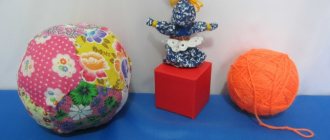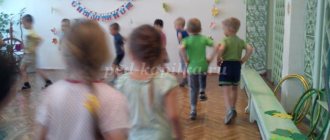Didactic games on the topic “Wild Animals” card index on the world around us on the topic
Didactic games on the topic “Wild Animals”
Game “Name it in order” Goal: to develop visual memory and attention, to activate the vocabulary of nouns on the topic.
Look at the pictures and remember them. I will remove them all, you remember in order.
(6-7 subject pictures on the topic).
Game "Who has who?"
Purpose: using the genitive case of singular and plural nouns.
The bear has ... (bear cub, cubs). The fox has ... (fox cub, fox cubs). The squirrel has ... (baby squirrel, baby squirrels). The she-wolf has ... (wolf cub, wolf cubs). The hedgehog has ... (hedgehog, hedgehog). The hare has ... (little hare, little hares).
Game "Name the Family"
Goal: to introduce children to the names of wild animals and their families; develop children's speech.
Dad is a bear, mom is ... (mother bear), cub is ... (bear cub). Dad is a wolf, mom is ... (she-wolf), cub is ... (wolf cub). Dad is a hedgehog, mom is ... (hedgehog), baby is ... (hedgehog). Dad is a hare, mom is ... (hare), baby is ... (bare). Dad is a fox, mom is ... (fox), cub is ... (fox).
Game “Who Lives Where?”
Purpose: to consolidate the form of the prepositional case of nouns.
On the board are pictures of wild animals (bear, fox, wolf, squirrel, hare, etc.). On the teacher’s table are pictures of their homes (burrow, den, lair, hollow, bush). Children place a picture of a home under a picture of the corresponding animal.
The squirrel lives in a hollow. The bear lives in a den. The fox lives in a hole. The wolf lives in a den. The hare lives under a bush.
Game "Who loves what?"
Goal: to consolidate the accusative case of nouns.
On the teacher’s table there are pictures: carrots, cabbage, raspberries, honey, fish, nuts, pine cones, mushrooms, acorns, tree bark, grass, chickens, hares, sheep, etc. Children put pictures to the corresponding animal.
The squirrel loves nuts, cones, mushrooms, and acorns.
Game "Choose a Word"
Goal: to teach children to select and name feature words and action words.
Bear (what?) ... (brown, club-footed, clumsy). Wolf (what?) ... (gray, toothy, angry). Hare (what?) ... (long-eared, cowardly, timid). Fox (what?) ... (cunning, red, fluffy).
The bear (what is he doing?) ... (sleeping, waddles, clumsily). Wolf (what is he doing?) ... (howls, runs away, catches up). The fox (what is it doing?) ... (tracks, runs, catches).
Game “Recognize the beast by description”
Goal: to teach children to recognize animals by description; develop children's thinking and speech.
- Cowardly, long-eared, gray or white. (Hare.) - Brown, club-footed, clumsy. (Bear.) - Gray, angry, hungry. (Wolf.) - Cunning, red-haired, dexterous. (Fox.) - Agile, thrifty, red or gray. (Squirrel.)
The game “Who gives what voice?”
Goal: to introduce children to the voices of wild animals.
- Tell me, how do animals sound? - What does the wolf do - ... (howls). - What is the fox doing - ... (yelps). - What is the bear doing - ... (roars). - What does a squirrel do? ... (clicks).
Game “Name it kindly”
Goal: to teach children to form nouns using diminutive suffixes. Don't yawn, my friend, but say a word. Squirrel - squirrel Fox - fox
Game "One - Many"
Goal: to teach children to form plural nouns in the nominative and genitive cases. We are little wizards, There was one, but there will be many. Squirrel - squirrels - a lot of squirrels Bear - bears - a lot of bears
Game "Count!"
Goal: to teach children to coordinate nouns with the numerals “one”, “two”, “five”. We always know how many there are, We count everything well. One bear - two bears - five bears One hedgehog - two hedgehogs - five hedgehogs One squirrel - two squirrels - five squirrels
Didactic game “Whose tail? »Goal: consolidate knowledge about animals, develop memory, thinking, attention and fine motor skills.
Progress of the game: One morning the forest animals woke up and saw that everyone’s tails were mixed up: the hare had a wolf’s tail, the wolf had a fox’s tail, the fox had a bear’s tail…. The animals were upset. Is a wolf's tail suitable for a hare? Help the animals find their tails by answering the question “Whose tail is this?” "Here is the wolf's tail. What is he like? (gray, long). Whose tail is this? - wolfish. Whose tail is this - small, fluffy, white? - hare. Etc. Now all the animals have found their tails.
Game “Change the words according to the model”
Purpose: formation of possessive adjectives.
Fox nose - ... (fox nose). Fox paw - ... (fox paw). Fox eyes - ... (fox eyes). Fox hole - ... (fox hole).
Game "On the contrary"
Goal: formation of antonym words.
The elk is big, and the hare is ... (small). The wolf is strong, and the squirrel is... (weak). The fox has a long tail, and the bear has ... (short).
Game "Fourth wheel"
Goal: to teach children to identify their essential features in objects and make the necessary generalizations on this basis, to activate their subject vocabulary.
Look at the picture, name the extra object and explain your choice.
Squirrel, dog, fox, bear
Game "Fold the picture"
Goal: to teach children to put together a picture from parts; develop holistic perception, attention, thinking.
The child has a picture of a wild animal, cut into 4 parts. - What kind of animal did you get? (Fox.)
Game “Composing a story-description”
Goal: to teach children to compose a descriptive story about an animal based on a plan diagram, to develop children’s speech.
Children compose a story about the appearance of a wild animal according to plan.
Summary of the didactic game “Wild and Domestic Animals.” (for the second younger group)
Summary of the didactic game “Wild and Domestic Animals” for the second junior group.
Educational goals:
Learn to listen carefully to the teacher and answer questions. Educational goals:
Continue to introduce children to the classification of animals (wild, domestic). Strengthen the ability to compare, find similarities and differences.
Developmental goals:
Increase children's speech activity and develop visual perception.
Preliminary work:
Reading stories about animals, board games with domestic and wild animals. Didactic games “Remember and name”, “Guess who it is”, “Whose mother is this”, “Find commonality”.
Equipment:
Forest, house, demonstration material from the series domestic and wild animals, laptop.
Organizing time.
- Guys, today we will go to the forest. How can you get there? (Developmental dialogue).
— We will go to the forest by bus. To get on the bus we need tickets. But the tickets are not simple. Be very careful. (The teacher shows tickets - geometric figures cut out of colored paper of different colors. Children name the geometric figure, color and sit on chairs with geometric figures and colors matching the tickets). Everyone sat down, let's go! (sound of a bus).
Main part.
- So we arrived in the forest. (The sound of the forest. Children go to a rug, a forest clearing, and sit on small pillows.)
-Who do you see in the clearing? (figures of wild and domestic animals in the clearing. Developmental dialogue).
-What's unusual here?
- Yes, children and pets live next to people, people feed them, build housing for them. A cow, a sheep, a horse and a goat came to a forest meadow to nibble grass and got lost.
-Who really lives in the forest?
-Yes, children, wild animals live in the forest. They find their own food, no one cares for them.
“These animals are lost and need to be escorted home.” Shall we help them?
(On one side of the room there is a toy model of a house and yard, and on the other there is a forest. Children name the animal and “show it off to their house”).
— Well done everyone, the animals are very grateful to you. And now it's time to return to our kindergarten. (The children get on the bus and leave to the sound of the bus.)
Bottom line.
- Well done boys. Tell me, please, where were we today? What were we doing? (Developmental dialogue).
MBDOU KINDERGARTEN No. 34 “RAINBOW” COMBINED TYPE EMR RT
Summary of the didactic game “Wild and Domestic Animals.”
(for the second younger group)
Prepared by:
Gayazova M.M.
Publication address:





